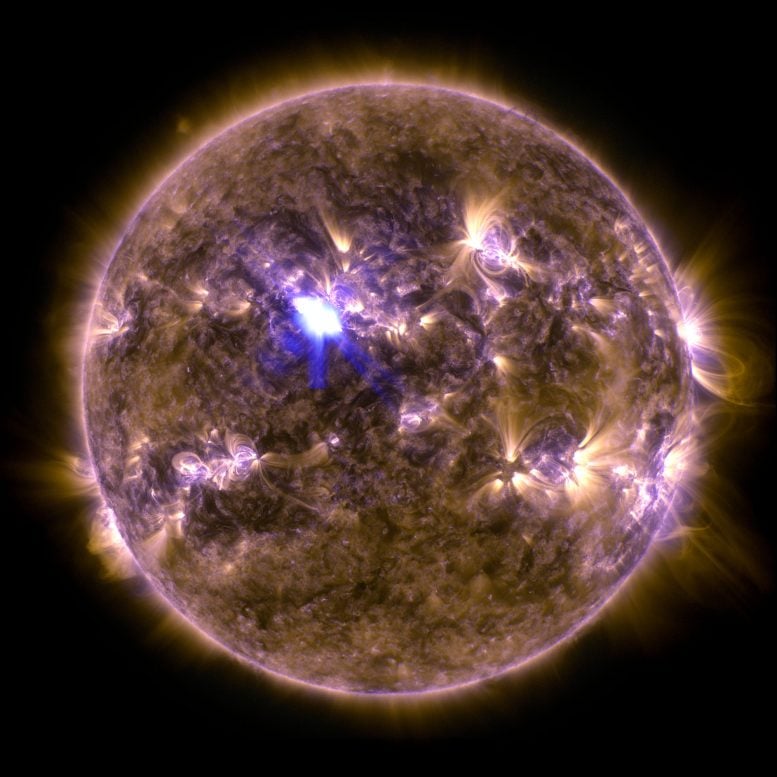
NASA’s Solar Dynamics Observatory captured this image of an M6.5 class flare at 3:16 EDT on April 11, 2013. This image shows a combination of light in wavelengths of 131 and 171 Angstroms. Credit: NASA/SDO
NASA’s Solar Dynamics Observatory captured an image of an M6.5 class flare yesterday, April 11, 2013. The flare was also associated with an Earth-directed coronal mass ejection (CME).
The sun emitted a mid-level flare, peaking at 3:16 a.m. EDT on April 11, 2013. The M6.5 flare on the morning of April 11, 2013, was also associated with an Earth-directed coronal mass ejection (CME), another solar phenomenon that can send billions of tons of solar particles into space and can reach Earth one to three days later. CMEs can affect electronic systems in satellites and on the ground. Experimental NASA research models show that the CME began at 3:36 a.m. EDT on April 11, leaving the sun at over 600 miles per second (3.5 million kilometers per hour).
Solar flares are powerful bursts of radiation. Harmful radiation from a flare cannot pass through Earth’s atmosphere to physically affect humans on the ground, however — when intense enough — they can disturb the atmosphere in the layer where GPS and communications signals travel. This disrupts the radio signals for as long as the flare is ongoing, anywhere from minutes to hours.
This flare is classified as an M6.5 flare, some ten times less powerful than the strongest flares, which are labeled X-class flares. M-class flares are the weakest flares that can still cause some space weather effects near Earth. This flare produced a radio blackout that has since subsided. The blackout was categorized as an R2 on a scale between R1 and R5 on NOAA’s space weather scales.
This is the strongest flare seen so far in 2013. Increased numbers of flares are quite common at the moment, since the sun’s normal 11-year activity cycle is ramping up toward solar maximum, which is expected in late 2013. Humans have tracked this solar cycle continuously since it was discovered, and it is normal for there to be many flares a day during the sun’s peak activity.
Updates will be provided as needed on the flare and its associated coronal mass ejection (CME), another solar phenomenon that can send solar particles into space and affect electronic systems in satellites and on Earth.
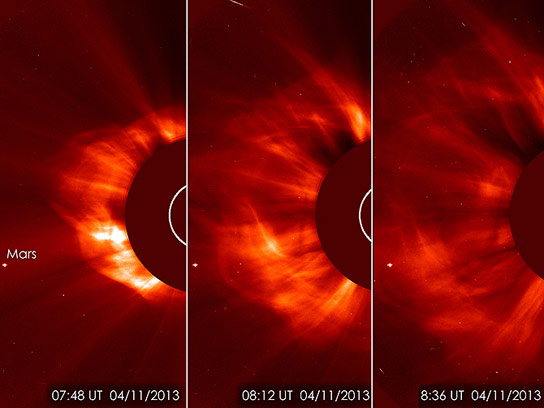
The joint ESA/NASA Solar Heliospheric Observatory (SOHO) captured this series of images of a coronal mass ejection (CME) on the morning of April 11, 2013 over the course of 3:48 EDT to 4:36 EDT. Mars can be seen on the left. Credit: ESA&NASA/SOHO/GSFC
Earth-directed CMEs can cause a space weather phenomenon called a geomagnetic storm, which occurs when they connect with the outside of the Earth’s magnetic envelope, the magnetosphere, for an extended period of time.
The recent space weather also resulted in a weak solar energetic particle (SEP) event near Earth. These events occur when very fast protons and charged particles from the sun travel toward Earth, sometimes in the wake of a solar flare. These events are also referred to as solar radiation storms. Any harmful radiation from the event is blocked by the magnetosphere and atmosphere, so cannot reach humans on Earth. Solar radiation storms can, however, disturb the regions through which high-frequency radio communications travel.
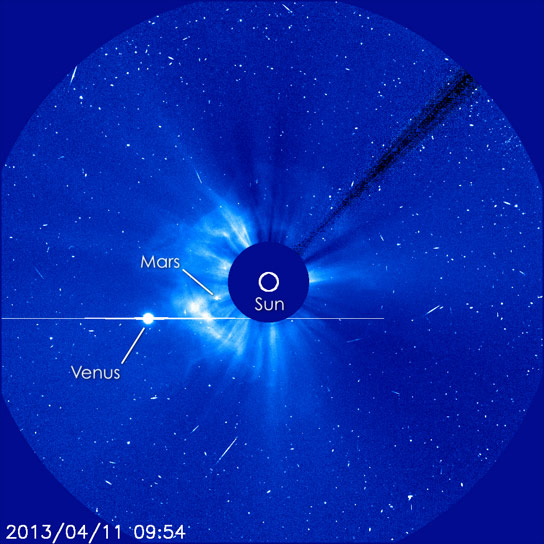
SOHO also captured this coronagraphic (a telescopic attachment designed to block out the direct light from a star so that nearby objects can be seen) image of the CME as it moves further out into the heliosphere. Credit: ESA&NASA/SOHO/GSFC
NOAA’s Space Weather Prediction Center (http://swpc.noaa.gov) is the United States Government official source for space weather forecasts, alerts, watches, and warnings. NASA and NOAA – as well as the US Air Force Weather Agency (AFWA) and others — keep a constant watch on the sun to monitor for space weather effects such as geomagnetic storms. With advance notification many satellites, spacecraft, and technologies can be protected from the worst effects.




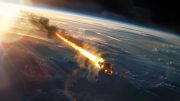

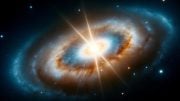


…I can only rely on what your equipment reveals,I went the carpentry way because I was to hyper to sit still,I always loved my science though…my step-dad was a caveman and couldn’t turn a screwdriver and science was sissy stuff to him,so I had to play “macho-man” and try and resolve everything by punchin’ somebody in the nose! I can’t sit still sometimes when more actual information is uncovered that isn’t just a theory especially when I was exercising my own in my head and I was vindcated!my landscapimg always helped me focus so clearly as I worked this amazing planet we call home,even mother Earth has information yet to be discovered,so do us people like me a favor and to the best of your abilities and in this information age of ours put it out there,oh and stay away from the military theres enough bombs,bullets and macho men!